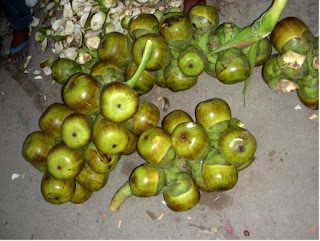 |
| Tal tree (তাল গাছ) |
 |
| তালের শাঁস |
The customary way this natural product is eaten is the point at which the external packaging is as yet unripe while the seeds are eaten as the organic product. Yet, in the event that the whole organic product is left to age, the stringy external layer of the palm natural products can likewise be eaten crude, bubbled, or broiled. At the point when this happens, the organic product takes a purple-blackish tint and tastes like coconut substance. The skin is likewise eaten as a feature of the organic product like how mango skins are regularly expended alongside the natural product. Bengali People have idealized the specialty of making different sweet dishes with the yellowish thick fluidic substance got from a ready palm natural product. These incorporate Mustard oil seared Taler Bora, on the other hand browned in Sunflower oil (তালের বড়া), or blended with thickened drain to frame Taal-kheer (তাল ক্ষীর).
Getting the sap customarily includes tapping the top shoots and gathering the dribbling juice in hanging earthen pots. The juice so gathered before morning is invigorating and light drink called Thaati Kallu (থাতি কাল্লু) in Telugu, Neera (নীরা) in Marathi and "Pathaneer" (পাটানীর) in Tamil is to a great degree cool in sensation, and has a sugary sweet taste.[citation needed] The juice gathered in night or after maturation ends up plainly sharp, and is called Tadi (তাঁড়ি) in Marathi. Tadi is expended for the most part by beach front villagers Maharashtra as a crude hard beverage.[citation needed]
A sugary sap called flavor, can be gotten from the youthful inflorescence, either male or female. Hard stuff is aged to make a drink called arrack, or it is concentrated to an unrefined sugar called jaggery or Taal Patali (তাল পাটালী) in Bengali and Pana Vellam or Karuppukatti in Tamil. It is called Gula Jawa (Javanese sugar) in Indonesia, and is broadly utilized as a part of Javanese food. Furthermore, the tree sap is taken as a purgative, and is accepted to have therapeutic virtues that have likewise been credited to other parts of the plant.
For my other blog Please CLICK HERE

Hi, I have read your post and it was very nice. Keep going your good work.
ReplyDeleterenewable Solar resources
Hi,
ReplyDeleteI have also seen your post and it was informative. I have a blog site like yours. Please pay a visit here.
VISIT HERE